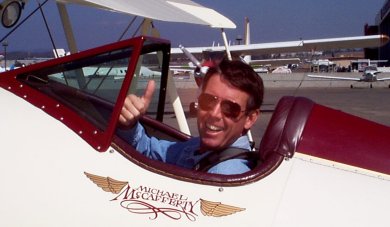Flying Europe in an open-cockpit biplane in the summer of '97. Three months, 11 countries. Low and Slow.
Sunday, November 28, 2010
Final, final, final edit...
Now just waiting for the cover to be adjusted for the reduced number of pages (less is more, right?) and then order the final, final, final proof to be sure everything is perfect (ha!) and it should be good to go.
Tuesday, November 23, 2010
Cover update
There will probably be only 1, or 2 max, more cover updates before the book goes into the first printing.
I'm in the process of final proofreading now.
ETA is within a week after Thanksgiving.
Patience...
Sunday, November 21, 2010
Additional Stories Published Elsewhere
Saturday, November 13, 2010
Short URL: AirMikie.com
Splendor On The Grass
With Cathy Foley, just a few moments after her first open cockpit biplane ride.
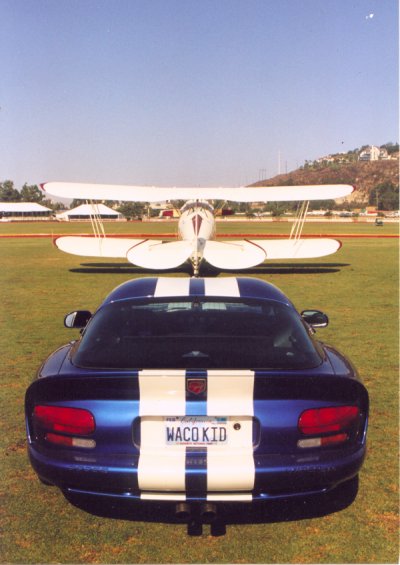
AKA: "Sundance"
The true story of "The Mikie Mooneuver"
There is a tradition in military aviation that when a man enters the fraternity of pilots, he is bestowed a call sign (name) by his instructor. In this case, my instructor was Vince Moore and his call sign is "Bluestreak". For better or worse, the student is known by this name forever more to his fellow pilots. The name is usually a reference to some aspect of the student's early flying experience.
My call sign was given in recognition of my discovery/creation of what I have called "The Mikie Mooneuver", which was simple in concept, but could only be achieved under rare circumstances which included the position of the sun and moon at the moment of sunset, in cold and clear weather. Once these conditions are met, the pilot can create the incredible experience of 3 sunsets, 2 sunrises, 3 moon rises and 2 moon sets all within 30 minutes.
I discovered this delightful bit of flying by accident, and on a whim, when I was flying low over the surf, at sunset along the oceanfront between Carlsbad and La Jolla. It was a spectacularly clear day after a winter storm has passed through and there was a chill in the autumn air. I was expecting a "Green Flash" to occur as the conditions were excellent for this rare event, but it was not to be. Sometimes, even though the conditions seem so perfect, it just doesn't happen. I guess we just don't know everything there is to know about the Green Flash.
Regardless, it was a fantastic sunset. When the sun finally disappeared from view, it was so awesome a sight that I wanted more, and instinctively pulled back on the control stick of the biplane, knowing intuitively that more altitude would allow me to see the sun again!
I had the idea that the sun would actually seem to rise back up out of the ocean as I got higher and higher in my climb. A Mikie-made sunrise on the western horizon!And, obviously, just simply holding my new altitude would allow the sun to sink again, persistently, into the sea. A Mikie-made sunset, effortlessly!!!
This was too much fun! I had to do more!! Climbing again, I watched the now expected miracle of the sun rising out of the western sky. Although this time, things happened a bit more slowly. Airplanes climb faster closer to sea level because the air is more dense. Each thousand feet of climb will be slower than the one before.
But at last the sun does finally rise again above the ocean, and once there I fly level circles to simply await and celebrate the third sunset.
I was feeling pretty smug about my new discovery, but I was totally stunned, on coming around to the east on one of those circles to be confronted with the very top edge of a full moon rising up over the faraway mountains. No one in San Diego could see that moon at that time, only me because of my great altitude, and only I would have known instinctively what to do with it! I continued my circling, now having much more fun, knowing that I was about to watch 3 moonrises and 2 moon sets simply by descending and waiting, just the reverse of the game I played with the sun.
I was completely elated with this amazing experience. I talked with many other pilots about this, expecting a reply like: "Oh, sure, I've done twenty in a row. Happens all the time." Only I didn't hear that at all. Most pilots were unaware of such a possibility, and only some, while pleased with the principle at work, had never actually done it.And so, in the fullness of time, and in recognition of this event, I was given the name "Sundance".
Cover edits
After 10 years of building my startup software company, I needed a rest, so I accepted an offer to buy my company, and started living my dream. I bought an extraordinarily beautiful open-cockpit biplane, then learned how to fly, and for the next 7 years I lived the life of a winged nomad.
For three months during the summer of 1997, I "went flying", low and slow, exploring Europe's coastline, islands, Alps, big-cities and tiny villages. The non-stop discovery of foreign lands, culture, people, flying and adventure made it the greatest experience of my lifetime.Here is the true story, the complete collection of 94 emails, one per day, with photos, sent to friends back home.
Next Flying Story to Be Written?

About the Biplane: Waco YMF-5, #N50YM and #N250YM,

The Biplane
The Spirit of Adventure II bought this incredibly beautiful biplane in 1993,
It was the 50th one they built, so they were very proud of it.
I told them I couldn't fly, but that didn't seem to matter.
Until I tried to fly it for the first time in a crankin' crosswind.
After two hours of torturing the biplane, chief pilot Carl Dye said:
"Tell me again how long you've been a pilot?"
I told him: "I'm not a pilot."
He says: "We don't really teach people how to fly here."
So I told him: "Let's get this biplane back to San Diego, and I'll figure it out from there."
And so the adventures began...
This is the airplane I used to learn how to fly.
It was an extraordinary feeling to finally fly solo,
and then to earn my Private Pilot license (November 18, 1993) in this work of art.
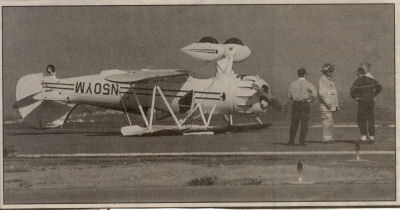
(click for BIG image)
One of my instructors (some wannabe pilots need more than one teacher) decided to do a check flight after some routine maintenance, but he came in for a landing with the parking break on. Boy, was he surprised when it flipped over the instant of touchdown!
He was unhurt (except for his pride), but the biplane was a total loss.
On that day, February 24, 1994, he earned the call-sign "Flipper".
I traded the broken bits, and the insurance settlement, for a new biplane.
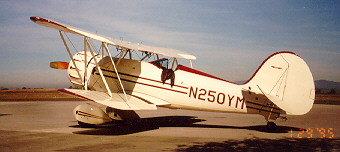
This is biplane number two, purchased May 1994.
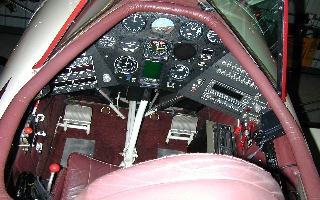
The biplane is also outfitted with a video camera in the right lower wing, wired to a VCR and monitor in the cockpit. With this setup I can make videos (or watch them!) as I fly.
Other special features: Auxiliary fuel tanks. Total fuel 72 gal. Total endurance 4+ hours. Range approximately 400 miles depending on winds, using cruising airspeed of 100 mph.
Baggage: 75 lbs. in rear baggage compartment, 25 lbs in the front baggage compartment.
to buy one of your own, new or used,
or just to look at some neat photos,
and learn more about this unique aircraft,
click on the link below
Waco Aircraft Company
in Battle Creek, Michigan
About the aviator/author
Flying Experience
Ratings
Hours
Aircraft flown:
Some Long Distance Flights
Summer 1997. Three months of touring Europe. The Waco was flown from San Diego to the factory in Lansing Michigan (now located in Battle Creek), then disassembled, put in a 40-foot container and shipped to LeHavre, France, then trucked to LeBourget airport in Paris, where it was reassembled and displayed at the Paris Air Show June 15-22. From there on it was fun flying throughout France, Switzerland, Germany, Luxembourg, Belgium, Netherlands, Denmark, England and Ireland.
Summer 1996. A 57-day tour of the USA, from San Diego to Maine and down the east coast to Kitty Hawk, North Carolina, then returning to San Diego.
Summer 1995. A one week tour of the west coast of the US, flying from San Diego to Canada, all along the surfline.
Summer 1995. A 20-day tour of the western US, Rocky mountains.
Summer 1994. A 6-week tour of the US, starting with taking delivery of the second new plane (N250YM) in late May, in Lansing Michigan, and flying to the east coast and back to San Diego.
Proofs!

Just received 5 proof copies from createspace.com

